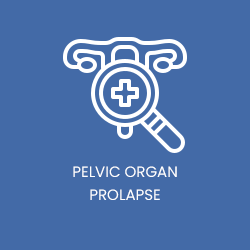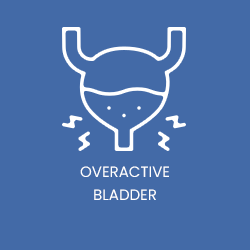Involuntary loss of large or small amounts of urine is called urinary incontinence.
Urine leak while coughing, sneezing, laughing, or lifting weight is called Stress Urinary Incontinence. Usually, SUI starts due to weakness of the perineal muscles due to multiple pregnancies, vaginal deliveries, or obstructed labour.
Urine leaks before reaching the restroom are referred to as urge urinary incontinence (UUI). UUI can be associated with Frequency and/or Nocturia.
Urinary incontinence (continuous) with a full bladder is called overflow incontinence. Usually, in neurogenic chronic urinary retention, the patient experiences overflow incontinence. Typically, an indwelling Foley's catheterization is required for 3-4 weeks, followed by a urodynamic study to evaluate the bladder. If UDS finds an atonic bladder, the patient may require clean intermittent catheterization or an indwelling catheter.
Urge Urinary Incontinence with Stress Urinary Incontinence is called Mixed Urinary Incontinence. Usually, for MUI, you must require treatment for UUI first. The patient should then be evaluated after some time, which may necessitate a urodynamic study. Then, depending on the patient, bothersome symptoms may require treatment for stress urinary incontinence.
An overactive bladder represents a collection of symptoms. These symptoms include:
Urinary tract infections are more common in females than in males. There is an almost 30 times higher incidence rate. Most women have urinary tract infections at some point in their lives. Urinary tract infections occur when bacteria get into the bladder. A UTI in the bladder is known as cystitis. This infection can spread into the kidneys, which are called pyelonephritis. Women get UTIs more often because their urethra is shorter than men's. This makes it easier for bacteria to enter the bladder. The female urethral opening is also near the vagina and anus.UTI is more common in women who are sexually active, postmenopausal, diabetic, or on catheterization.
Urinary tract infections are more common in females than in males. There is an almost 30 times higher incidence rate. Most women have urinary tract infections at some point in their lives. Urinary tract infections occur when bacteria get into the bladder. A UTI in the bladder is known as cystitis. This infection can spread into the kidneys, which are called pyelonephritis. Women get UTIs more often because their urethra is shorter than men's. This makes it easier for bacteria to enter the bladder. The female urethral opening is also near the vagina and anus.UTI is more common in women who are sexually active, postmenopausal, diabetic, or on catheterization.
Many changes occur in the body during pregnancy, including changes in the functioning and filtering of the kidneys, as well as changes in blood pressure status. Urinary tract infections are the most common problem among pregnant women.This results in low birthweight babies, intrauterine growth retardation, or the foetus dying suddenly. If the infection spreads to the kidneys, the patient must be admitted and given antibiotics.
Another problem is kidney and ureteric stones. This may lead to acute kidney infections. These problems are treated with medications or may require stenting. Urinary incontinence is also a major problem during pregnancy. Because of the weight of the fetus, a pregnant lady may experience urine leakage while coughing, sneezing, and laughing. This is called stress urinary incontinence and may continue in postpartum life as well. They have frequent urination and an extreme urge to
Genitourinary fistula is the most common complication of gynaecological and obstetric procedures. Its incidence rate is 1–3 per 1000 deliveries. It is more common in women who have an early-age pregnancy, cephalopelvic disproportion, and poor antenatal care, which results in obstructed labor.Hysterectomy can also cause bladder injuries (2.9%), ureteric injuries (1.8%), and fistula formation. Pelvic malignancy, pelvic irradiation, trauma, and foreign body erosions are other common factors. Vesicovaginal fistulas are more common, followed by ureterovaginal fistulas and vesicouterine fistulas.
Common urological problems in women





